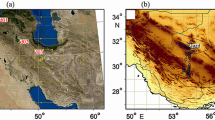Abstract
Cloud seeding projects may have the time scale of half a century and cover the planetary-scale surface. Such activities among the positive also have negative consequences that include environmental pollution. Year after year cloud seeding over certain areas could produce large amounts of seeding agents washed out in precipitation. The sampling of these deposits is therefore important, but not applied in large space and time scales due to a high cost. As an alternative, the cloud seeding project measurements may be used for finding the deposit spatial pattern and locations of its maximum. In this study, we established the method for finding the spatial distribution of deposited silver iodide over a selected area after hail suppression using the observed characteristics of seeded hailstorms. The estimation of the silver iodide deposit maximum is 155 μg m−2 during a 6-year period. Our findings agree well with those obtained from sampling silver content in precipitation during the other convective cloud seeding experiments. On the other hand, our method gives an answer of where to place the samplers, and hence more detailed chemical analysis and monitoring can be done in the future. The proposed methodology may be applied for any other target area and cloud seeding scenario.






Similar content being viewed by others
References
Abshaev GK, Sulakvelidze II, Burtsev LM, Fedchenko MK, Jekamukhov AM, Abshaev BK, Kuznetsov AM, Malkarova AD, Tebuev PA, Nesmeyanov II, Shakirov IN, Shevela GF (2006) Development of rocket and artillery technology for hail suppression. In: Achievements in weather modification. Department of Atmospheric studies, Abu Dhabi, pp 109–127
Barnolas M, Rigo T, Llasat MC (2010) Characteristics of 2D convective structures in Catalonia (NE Spain): an analysis using radar data and GIS. Hydrol Eart Syst Sci 14:129–139
Ćurić M (1982) The development of the cumulonimbus clouds which moves along a valley. In: Agee EM, Asai T (eds) Cloud dynamics. Dordrecht, D. Reidel, 259–272
Ćurić M, Janc D (1992) Mountain influence on the areal characteristics of types of convective precipitation. Theor Appl Climatol 45:71–76
Ćurić M, Janc D (2011a) Comparison of modeled and observed accumulated convective precipitation in mountainous and flat land areas. J Hydrometeor 12:245–261
Ćurić M, Janc D (2011b) Analysis of predicted and observed accumulated convective precipitation in the area with frequent split storms. Hydrol Earth Syst Sci 15:3651–3658
Ćurić M, Janc D (2012) Differential heating influence on hailstorm vortex pair evolution. QJR Meteorol Soc 138:72–80
Ćurić M, Janc D, Vučković V (2007) Cloud seeding impact on precipitation as revealed by cloud-resolving mesoscale model. Meteorol Atmos Phys 95:179–193
Ćurić M, Janc D, Vučković V (2008) Precipitation change from a Cumulonimbus cloud downwind of a seeded target area. J Geophys Res 113:D11215. doi:10.1029/2007JD009483
Dennis AS (1980) Weather modification by cloud seeding. Academic Press, New York, pp 267
Dessens J (1998) A physical evaluation of a hail suppression project with silver iodide ground burners in southwestern France. J Appl Meteor 37:1588–1599
Fleagle RG (1974) Weather modification in public interest. University of Washington Press, Seattle, p 127
Henderson TJ (2006) Achievement in weather modification. Department of Atmospheric studies, Abu Dhabi, pp 8–21
Irwin RJ (1997) Environmental contaminants encyclopedia—silver entry. National Park Service-Water Resources Divisions-Water Operations Branch. Fort Collins, Colorado, p 88
Krauss TW, Santos JR (2003) The effect of hail suppression operations on precipitation in Alberta, Canada. In: Proceedings of the Eighth WMO scientific conference on weather modification, Casablanca, 7–12 Apr 2003, pp 279–282
Levin Z (2011) Lessons learned from 50 years of cloud seeding in Israel. In: Proceedings of tenth weather modification conference, Bali, 3–7th Oct 2011, pp P1–P4
Levin Z, Krichak SO, Reisen T (1997) Numerical simulation of dispersal of inert seeding material in Israel using a three-dimensional mesoscale model. J Appl Meteor 36:474–484
List R (2004) Weather modification—a scenario for the future. Bull Amer Met Soc 85:51–63
Lopez RE, Atlas D, Rosenfeld D, Thomas JL, Blanchard DO, Holle RL (1989) Estimation of areal rainfall using the radar echo area time integral. J Appl Meteor 28:1162–1175
Mather GK, Steffens FE, Fletcher L (1997) Results of the South-African cloud-seeding experiments using hygroscopic flares. J Appl Meteor 36:1433–1447
McKee JE, Wolf HW (1963) Water quality criteria. IInd edn. Publ no. 3a, California State Water Quality Board, CA
Radinović DJ, Ćurić M (2007) A specific evidence of hail suppression effectiveness in Serbia. J Wea Mod 21:75–84
Spiridonov V, Ćurić M (2005) The relative importance of scavenging, oxidation, and ice-phase processes in the production and wet deposition of sulfate. J Atmos Sci 62:2118–2135
Spiridonov V, Ćurić M (2009) Numerical simulation on physical and chemical processes in convective clouds. Asia–Pac J Atmos Sci 45:1–19
Wang G, Lou X, Hu Z, You L, Feng D, Zhang J, Shi A, Li S, Guo E, Wang Y, Fang W, Shi Y, Sun J (2006) Main achievements of Institute of Weather Modification. Department of Atmospheric studies, Abu Dhabi, pp 131–141
Wisniewski J, Sax RJ (1979) Silver concentration from seeded and nonseeded Florida Cumuli: 1973–1975 results. J Appl Meteor 18:1044–1055
Wisniewski J, Cotton WR, Sax RJ (1976) Silver content of precipitation from seeded and nonseeded Florida cumuli. J. Appl Meteor 15:1004–1011
Acknowledgments
This research was supported by the Ministry of Science of Serbia. We gratefully acknowledge Mr. Dragomir Bulatović for technical preparation of the figures.
Author information
Authors and Affiliations
Corresponding author
Additional information
Responsible Editor: R. Roebeling.
Rights and permissions
About this article
Cite this article
Ćurić, M., Janc, D. The spatial distribution of deposited seeding material in the Earth boundary layer during weather modification. Meteorol Atmos Phys 118, 31–36 (2012). https://doi.org/10.1007/s00703-012-0207-7
Received:
Accepted:
Published:
Issue Date:
DOI: https://doi.org/10.1007/s00703-012-0207-7




